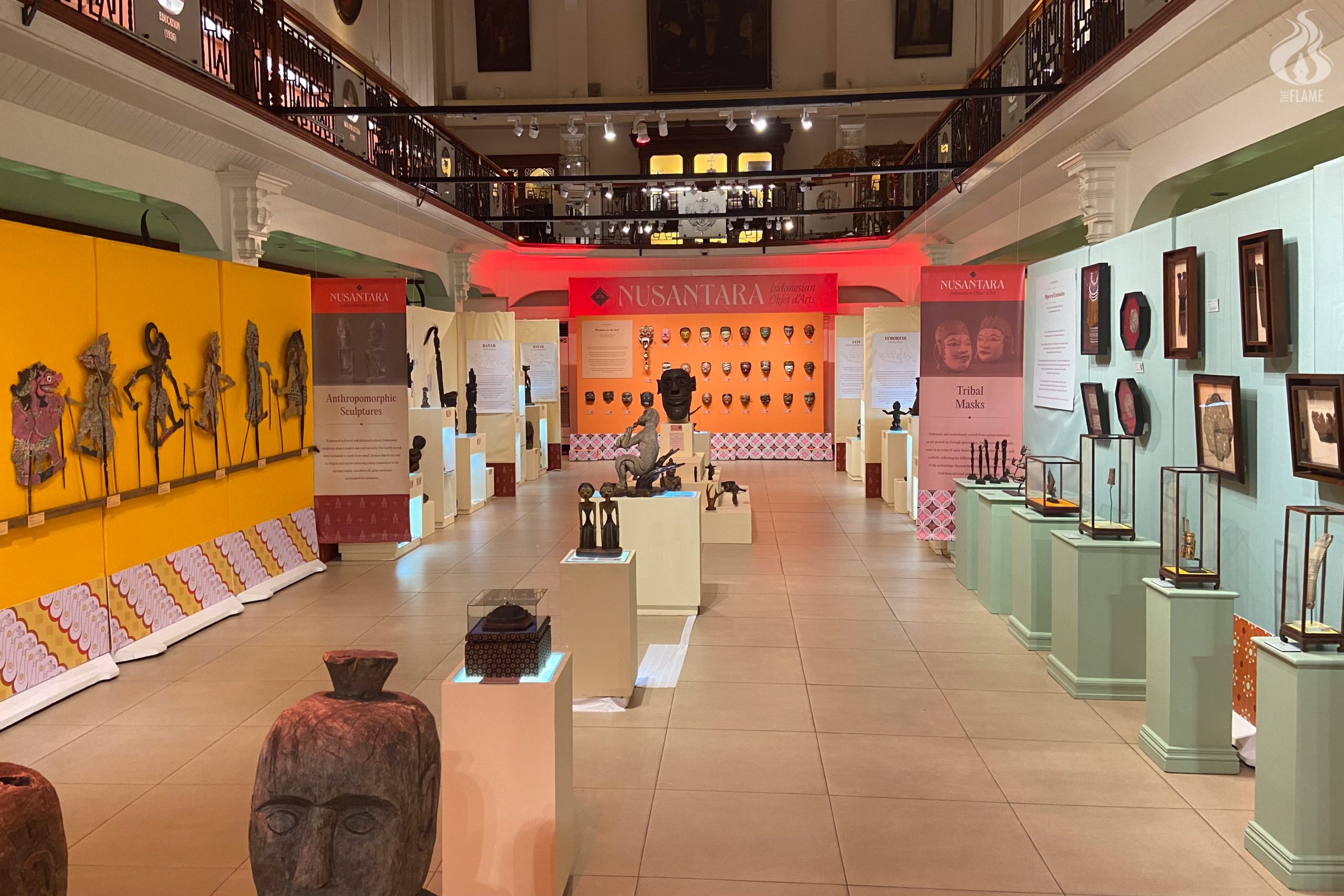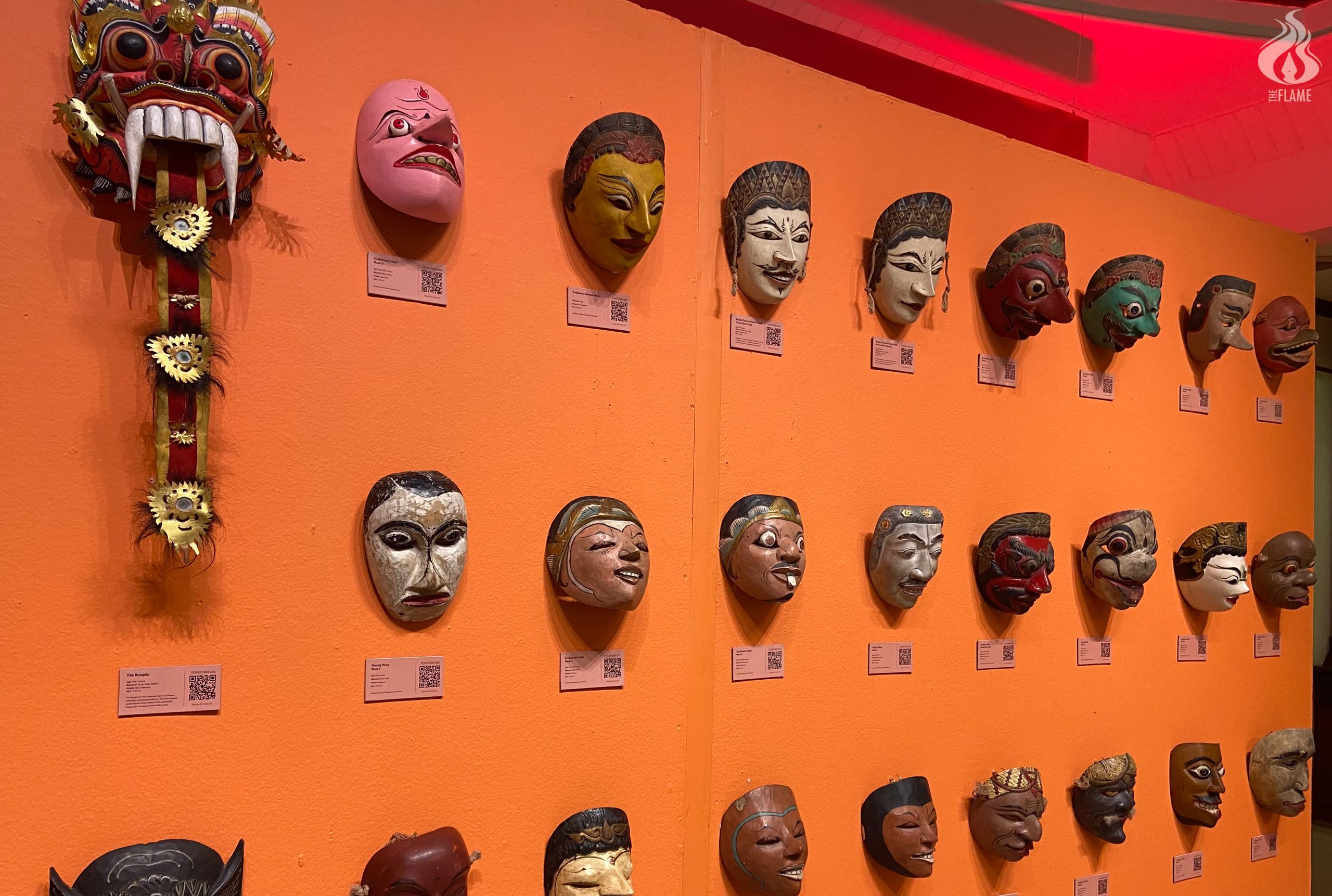A DIFFERENT air has been pervading the University of Santo Tomas Museum lately. The moment visitors enter the museum, they become calmer. They walk slower; they speak in hushed tones. They are mesmerized, as though they had stumbled upon a strange place.
This is the effect of “Nusantara: Indonesian Objets d’Art,” a new exhibition at the UST Museum’s main gallery, which features around 150 Indonesian artifacts from the 19th and 20th centuries. It opened on Sept. 5 and runs until Sept. 25.

Presented in partnership with Artiste Musaeum, a private museum in Quezon City, the exhibition showcases a sample of tangible Indonesian heritage found throughout the different regions of the Indonesian archipelago.
The exhibited items come from the private collection of Anthony “Tonet” Gedang, a Filipino art collector and the exhibition’s curator. Gedang said the exhibit was initiated by Fr. Isidro Abaño, O.P., the UST Museum’s current director. This came after Abaño visited Gedang’s collection at the Artiste Musaeum, Gedang’s museum, where his collection of artworks, artifacts, bonsais, rocks and other curiosities are housed. The collection has about 20,000 objects.
“Father Abaño said the topic is up to me, as long as I can teach children, especially the students here, about how I started collecting, what collection I have, how I take care of them and what the students can learn from my collections,” Gedang told The Flame.
“That’s what Father asked me to do, and that’s what I’m doing now.”
Some items on the exhibition had been shown in various campuses in Manila in the past, such as in the Far Eastern University and the Adamson University. “But,” he revealed, “ngayon lang na ganito kabongga ‘yung exhibit (This is the only time the exhibit is as grandiose as this one).”

For its breadth and variety, the show does indeed stun. The objets d’art or ornamental items of artistic value featured in the show range from accessories, household items and daily implements, to theatrical masks, shadow puppets and statues of different persuasions.
To fairly represent the Indonesian archipelago, which has about 17,500 islands and more than 600 ethnic groups, is a difficult task to achieve in an exhibition. Although the show only occupies the first level of the main gallery (with a few wood sculptures displayed on the mezzanine), it nonetheless succeeds in offering a window into the diverse world of Indonesian culture. The effect is nothing short of entrancing.
The artifacts are organized according to the seven regional and ethnic group origins: Balinese, Timorese, Sumbese, Leti, the Dayak, the Nias and the Batak. Visitors get to see and compare the nuances in the ways the different ethnic groups express their beliefs through art.
The sculptures that come from Bali, for instance, are noticeably more sinuous than the rest, a quality akin to the expressiveness of Indian art. There are striking statuettes of Ganesha, a Hindu deity often represented by an elephant-headed god, and Hanuman, the commander of the monkey army in the Sanskrit epic “Ramayana.” These reflect the centuries-long history of the Balinese people’s intense interaction with Indian culture and their rootedness in Hindu-Buddhism.
The seven ethnic groups have a commonality: all of them boast anthropomorphic figures. Some are elongated and angular. Others are round and organic. Some sit, some stand, but all of them are calm and assured, as though locked in meditation.
They were created for various animistic purposes: as guardians of a household, icons of fertility and, most intriguing, as receptacles for the spirit of a household’s ancestor to temporarily reside in. They are not encased in glass vitrines, so that visitors may look at them closely.

Many other curiosities abound in the show. One is a mamuli, a diamond-shaped ear ornament from the Sumba people in eastern Indonesia, given by the family of a groom as an heirloom to the family of his bride. The one in the show is decorated with seahorses at its base.
Hanging on a wall at the far end of the exhibit are masks used for theatrical performances called topeng, tantalizing viewers with their twisted expressions. One of the masks, mounted on a pedestal, is gigantic in size and was used in funerary rites by the Batak people of northern Sumatra.
Another striking artifact is the naga morsarang, a medicine horn from the Toba Batak people. Replete with symbols from Batak mythology, it is carved out of a buffalo horn and wood by a village datu. A slender staff of about five feet and five inches, which the show describes as a “pure expression of Batak iconography,” stands next to it.
The datu uses these tools to carry out his duty as the village’s ritual expert: the former as his storage for potions used for healing and defense, and the latter as an aggressive magical weapon used against enemies. The description further explains that the latter only works through a magical substance called pukpuk.
Pukpuk, the datus’ guidebooks instruct, was created by kidnapping a child from a nearby village, raising them so that they would become loyal to the datu before killing them. The ashes were then applied to an object, creating a pangulubalang. The Batak people believed that through the spirit of the child, the object protects the village from illness, evil magic and attack by enemies. A pangulubalang image from the 18th century stands next to the staff in the show.
Rev. Fr. Gaspar Sigaya, O.P., the assistant to the prefect of libraries in the Miguel de Benavides Library, happened to be touring his students in the exhibition. When asked what he thought of the artifacts, he said it may only look “scary” for others, but for Indonesians, it is their culture.
“It’s their way of life, and it’s important that we get to see and appreciate cultures other than ours, too,” Sigaya said.

It is the celebration of diversity that is at the heart of the exhibition.
“It’s impressive,” Agus Widjojo, Ambassador of the Republic of Indonesia to the Philippines, told The Flame.
“Only introducing one of the ethnic groups is just not sufficient enough to understand about Indonesia. And here, in this exhibition, the arts of the various groups are covered. I think it brings the peoples of the Philippines and Indonesia closer to one another,” he added.
The exhibition’s title, “Nusantara,” is an Old Javanese term that refers to the whole Indonesian archipelago. Indeed, the show introduces a panoramic view of a Philippine neighbor to Filipinos. It is not a mere display of a wealthy art collector’s cabinet of curiosities but a door leading to the appreciation of a multifaceted nation, one that thrives through the differences and sameness of its peoples.
And yet it also illuminates, in the minds of Filipinos, dim rooms already familiar to them. After all, the word “nusantara” also refers to the whole Malay Archipelago, which includes the Philippines. Consider the objects long enough and you will see glimmers of Filipino culture seeping through. The wayang kulit, a traditional Indonesian shadow puppet made of leather, brings to mind the carillo shadow puppet tradition of the Tagalogs. The anthropomorphic statuettes all bear a semblance to the bulul of the Ifugao people, some of which may be seen on the mezzanine gallery. Both cultures share a deep regard for nature and community.
This, perhaps, is what makes the exhibition entrancing: what Filipino visitors are experiencing is a déjà vu in the Malay world. F – Eugene Lorenzo



